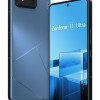Review: Asus PadFone X for AT&T
Screen(s)
The PadFone X has a 5-inch 1080p HD screen. It's an LCD panel and is fairly decent as far as high-def screens go. Colors are accurate and most elements on the screen are clear and sharp. I found the device somewhat difficult to use outdoors under sunny conditions, but it's plenty bright for indoor use. There's some brightness drop-off when the device is tilted side-to-side, but not too much; viewing angles are relatively decent. It's a good screen.
The Station stretches the screen from 5 inches to 9 inches, and ups the resolution from 1920 x 1080 to 1920 x 1200. The larger screen with (essentially) the same resolution means you're losing significant pixel density. It's acceptable to my eyes, but doesn't beat competing devices. Pixels are easily noticeable, and I found the Station needed the brightness setting cranked nearly all the way up even when used indoors. It's practically impossible to use the Station outdoors; sunlight obliterates it.
Signal
The PadFone X performed on par with other AT&T handsets tested throughout the greater New York City area. That means it remained connected to the network no matter where I took it, and I was able to make calls even when signal coverage was at its worst. It did take more than one attempt to connect calls in poor signal areas, though, and it dropped a couple of calls when switching cells. Data speeds were generally good on both HSPA+ and LTE. I didn't see much difference in speeds between the two networks, however, and things slowed down a little in weak coverage areas.
In case you're wondering, inserting the PadFone into the Station had no effect whatsoever on signal performance. It worked just as well in and out of the Station. The same goes for Wi-Fi, Bluteooth, and GPS performance. None of the radios were negatively impacted by the Station. On the whole, the PadFone performed just fine in the signal department.
Sound
The PadFone is not a good voice phone. Quality of calls passed through the earpiece are acceptable, almost bordering on good. There's little interference, but they sound a bit muffled to my ears. The problem is volume: there's just not enough of it. I really had to work hard to angle the earpiece into my ear to hear calls even in my quiet office. Calls are all but impossible to hear out in the real world. The speakerphone borders on useless. Call quality takes a significant dip when passed through the speakerphone. Voices were often patchy and cut out from time-to-time. Volume is the real killer. I could barely maintain a conversation in a dead-quiet room. It's simply not a viable option. Ringers are adequate and can get your attention when set all the way up, but if you leave them at 50% you might miss calls in loud spaces. The vibrate alert works well.
I was hoping the PadFone would automatically route speakerphone calls to the two, large stereo speakers on the front of the Station when docked. It doesn't. Instead, it still passes them through the anemic speaker on the back of the phone. What a lost opportunity. (Yes, I checked, there's no way to alter this behavior.)
The PadFone X is one of the first devices from AT&T capable of making calls using VoLTE technology. Unfortunately, VoLTE is only available in several markets scattered about the midwest. We were unable to test the PadFone's VoLTE capabilities.
Battery
Battery life is one of the PadFone's strong suits. Without the Station, the PadFone's 2,300mAh power supply had no problem delivering a full day of useful life no matter how much I punished it. If you find yourself in trouble, the PadFone includes a power saving mode that can be used to lengthen battery life by shutting down some aspects of the device, such as Bluetooth and so on.
The Station has its own 4,990mAh battery and charges the PadFone when docked. On days when I came close to draining the PadFone's battery, it was no problem at all to drop the phone into the Station and watch it charge back up even while I used it. You don't need to worry about battery life.


 Hands-On: Asus PadFone X
Hands-On: Asus PadFone X
 Hands-On: Asus Padfone Mini, PadFone X
Hands-On: Asus Padfone Mini, PadFone X
 AT&T to Sell Asus PadFone X June 6 for $200
AT&T to Sell Asus PadFone X June 6 for $200
 Asus PadFone X to Reach U.S. Consumers Thanks to AT&T
Asus PadFone X to Reach U.S. Consumers Thanks to AT&T
 Asus Goes Big with Zenfone 11 Ultra
Asus Goes Big with Zenfone 11 Ultra
 Asus PadFone X
Asus PadFone X




